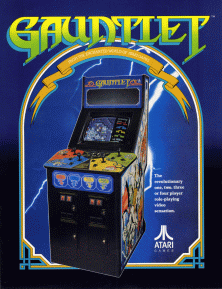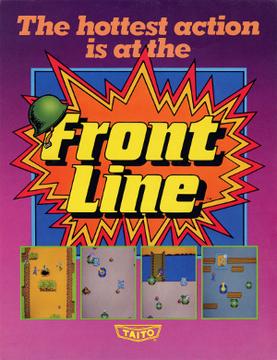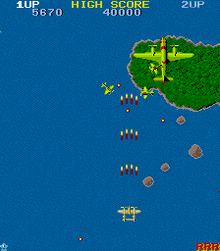
Arkanoid is a 1986 block breaker arcade game developed and published by Taito. In North America, it was published by Romstar. Controlling a paddle-like craft known as the Vaus, the player is tasked with clearing a formation of colorful blocks by deflecting a ball towards it without letting the ball leave the bottom edge of the playfield. Some blocks contain power-ups that have various effects, such as increasing the length of the Vaus, creating several additional balls, or equipping the Vaus with cannons. Other blocks may be indestructible or require multiple hits to break.

Ikari Warriors, known as Ikari in Japan, is a vertically scrolling run and gun video game released for arcades by SNK in 1986. It was published in North America by Tradewest. At the time there were many Commando clones on the market. What distinguished Ikari Warriors were rotary joysticks and a two-player cooperative mode. The rotary joystick controls were in turn based on SNK's earlier TNK III (1985). Ikari was originally intended to be an official licensed adaptation of the film Rambo: First Blood Part II (1985), but SNK were initially unable to acquire the rights to the film.

Gauntlet is a 1985 fantasy-themed hack-and-slash arcade game developed and released by Atari Games. It is noted as being one of the first multiplayer dungeon crawl arcade games. The core design of Gauntlet comes from 1983 Atari 8-bit dungeon crawl game Dandy, which resulted in a threat of legal action. It also bears striking similarities to the action-adventure maze game Time Bandit (1983).

1943: The Battle of Midway is a 1987 vertically scrolling shooter arcade video game developed and published by Capcom.

Karate Champ, known in Japan as Karate Dō, is a fighting game developed by Technōs Japan and released in arcades by Data East in 1984. A variety of moves can be performed using the dual-joystick controls using a best-of-three matches format like later fighting games. The game was commercially successful, especially in the United States where it was the highest-grossing arcade game of 1985 and the best-selling home computer game up until 1989. Karate Champ established and popularized the one-on-one fighting game genre, for which it is considered one of the most influential games of all time.

Super Sprint is a racing video game released by Atari Games and Midway Games in 1986. Up to three players drive Formula One-like cars on a circuit that is viewed from above. The game is a successor to Gran Trak 10 and the Sprint series, which were black-and-white games from the 1970s. A sequel, Championship Sprint, was released later in the same year.

Kung-Fu Master, known as Spartan X in Japan, is a side-scrolling beat 'em up game developed by Irem as an arcade game in 1984, and distributed by Data East in North America. Designed by Takashi Nishiyama, the game was based on Hong Kong martial arts films. It is a loose adaptation of the Jackie Chan, Sammo Hung, and Yuen Biao film Wheels on Meals (1984), called Spartan X in Japan, with the protagonist Thomas named after Jackie Chan's character in the film. The game is also heavily inspired by the Bruce Lee film Game of Death (1972), which was the basis for the game's concept. Nishiyama, who had previously designed the side-scrolling shooter Moon Patrol (1982), combined fighting elements with a shoot 'em up gameplay rhythm. Irem and Data East exported the game to the West without the Spartan X license.

Ghosts 'n Goblins, known as Makaimura in Japan, is a platform video game developed by Capcom and released for arcades in 1985. It is the first game in the Ghosts 'n Goblins franchise, and has since been ported to numerous home platforms.

Operation Wolf is a light gun shooter arcade game developed by Taito and released in 1987. It was ported to many home systems.

Commando, released as Senjō no Ōkami in Japan, is a vertically scrolling run and gun video game released by Capcom for arcades in 1985. The game was designed by Tokuro Fujiwara. It was distributed in North America by Data East, and in Europe by several companies including Capcom, Deith Leisure and Sega, S.A. SONIC. Versions were released for various home computers and video game consoles. It is unrelated to the 1985 film of the same name, which was released six months after the game.
1985 saw many sequels and prequels in video games, such as Super Mario Bros. and Kung Fu, along with new titles such as Commando, Duck Hunt, Gauntlet, Ghosts 'n Goblins, Gradius, Hang-On, Space Harrier, Tetris and The Way of the Exploding Fist. The year's highest-grossing arcade video games were Hang-On and Karate Champ in the United States, and Commando in the United Kingdom. The year's best‑selling home system was the Nintendo Entertainment System (Famicom) for the second year in a row, while the year's best‑selling home video game was Super Mario Bros.
1984 saw many sequels and prequels along with new titles such as 1942, Boulder Dash, Cobra Command, Jet Set Willy, Karate Champ, Kung-Fu Master, Yie Ar Kung-Fu and Punch-Out!! The year's highest-grossing arcade games were Pole Position in the United States, for the second year in a row, and Track & Field in the United Kingdom. The year's best-selling home system was Nintendo's Family Computer (Famicom), which was only sold in Japan at the time.

19XX: The War Against Destiny is a vertical scrolling shooter arcade game released by Capcom in 1995. The story takes place before a fictional 20th century war as a lone pilot tries to defeat an entire army and evil organization from starting another World War, which soon escalates to a nuclear apocalypse.

U.N. Squadron is a 1989 side-scrolling shooting game released by Capcom for the CPS arcade hardware and for the Super Nintendo Entertainment System. The game was released in Japan as Area 88, and is based on the manga series of the same name, featuring the same main characters. Their mission is to stop a terrorist group known as Project 4. It was followed by a spiritual successor Carrier Air Wing.

Yie Ar Kung-Fu is an arcade fighting game developed and published by Konami. It first had a limited Japanese release in October 1984, before having a wide release nationwide in January 1985 and then internationally in March. Along with Karate Champ (1984), which influenced Yie-Ar Kung Fu, it is one of the games that established the basis for modern fighting games.

Pole Position II is the sequel to racing simulation game Pole Position, released by Namco for arcades in 1983. As with its predecessor, Namco licensed this game to Atari, Inc. for US manufacture and distribution. Atari Corporation released a port as the pack-in game for its Atari 7800 ProSystem console launch in 1986. Pole Position arcade machines can be converted to Pole Position II by swapping several chips.

Gun.Smoke is a vertically scrolling run and gun video game and designed by Yoshiki Okamoto and released in arcades in 1985. Gun.Smoke centers on a character named Billie Bob, a bounty hunter going after the criminals of the Wild West.

Front Line is a military-themed run and gun video game released by Taito for arcades in November 1982. It was one of the first overhead run and gun games, a precursor to many similarly-themed games of the mid-to-late 1980s. Front Line is controlled with a joystick, a single button, and a rotary dial that can be pushed in like a button. The single button is used to throw grenades and to enter and exit tanks, while the rotary dial aims and fires the player's gun.

Varth: Operation Thunderstorm is an arcade game in the vertical scrolling shooter genre, published by Capcom in 1992. The game did not see a console port following its initial release, but 14 years later Digital Eclipse Software would port the game onto the PSP handheld, and later onto the PlayStation 2 and Xbox.

T.A.N.K. is a vertically scrolling multidirectional shooter developed and released in arcades by SNK 1985. It was published in North America as TNK III by Kitcorp. Versions of T.A.N.K. for home computers were released by Ocean Software for the ZX Spectrum, Commodore 64, and Amstrad CPC in 1987. A sequel was also released for the Nintendo Entertainment System titled Iron Tank.



















